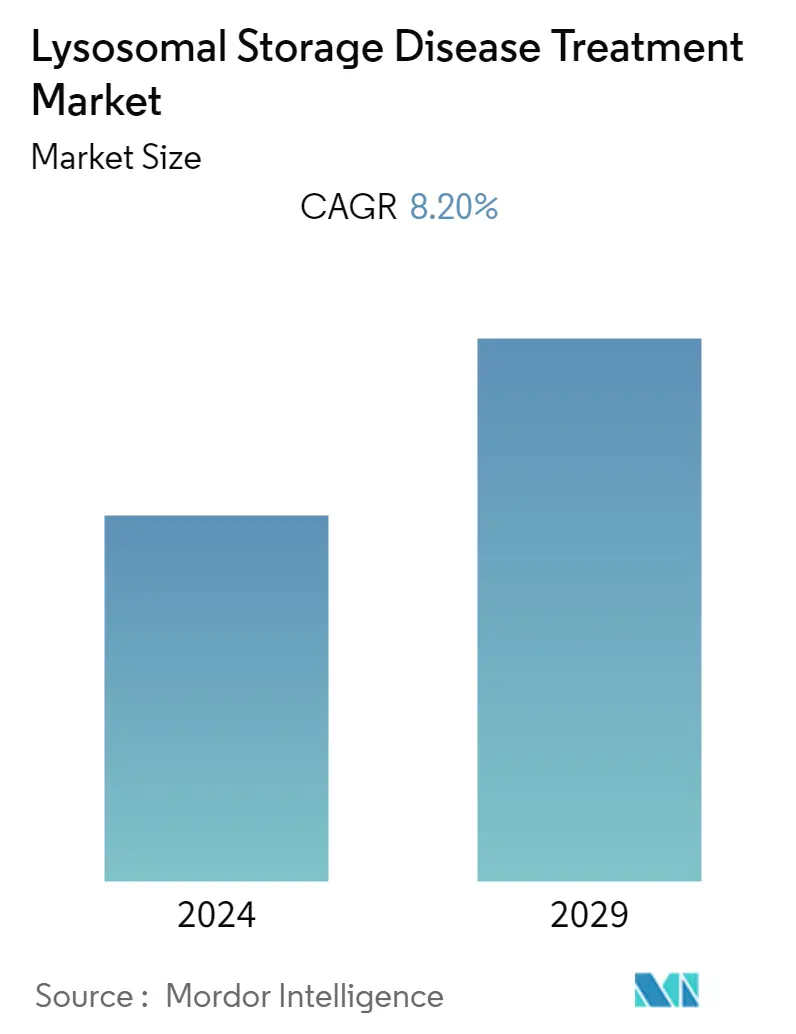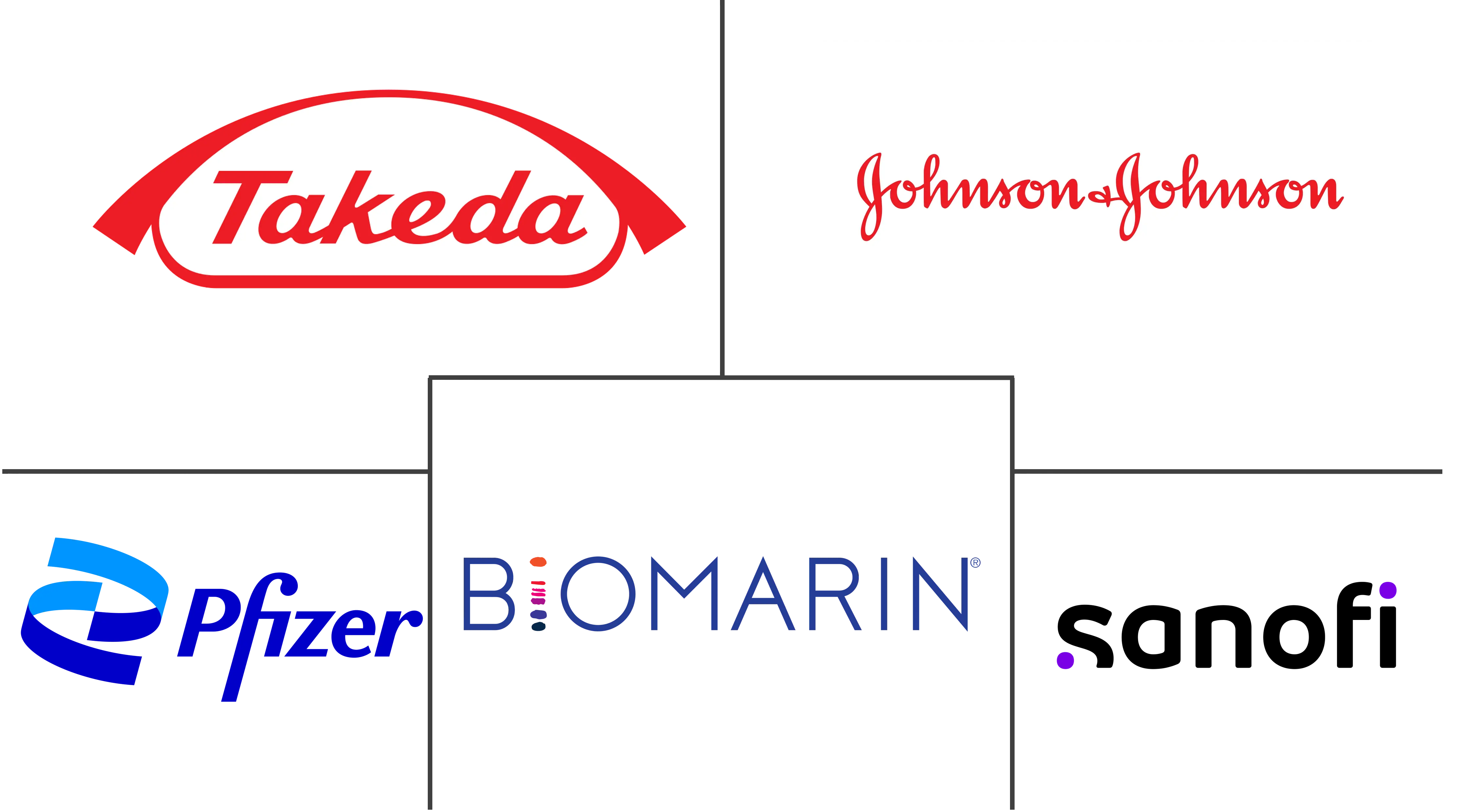Market Size of Lysosomal Storage Disease Treatment Industry

| Study Period | 2021 - 2029 |
| Base Year For Estimation | 2023 |
| CAGR | 8.20 % |
| Fastest Growing Market | Asia Pacific |
| Largest Market | North America |
| Market Concentration | Medium |
Major Players
*Disclaimer: Major Players sorted in no particular order |
Lysosomal Storage Disease Treatment Market Analysis
The lysosomal storage disease treatment market is expected to register a CAGR of 8.2% during the forecast period.
The growth of lysosomal storage disease treatment is driven by increased research and development, and the spread of awareness among people about the lysosomal storage disease. Furthermore, the increasing investment in research and development also contributes to market growth. As per the study published by the National Library of Medicine, in July 2022, when viewed as a group, LSDs are much more common. The combined incidence is between 1 in 5000 to 1 in 8000. As per the same source, both ethnicity and geography play a part in the incidence of LSDs. For example, Gaucher disease (GD) occurs in 1 in 40000 to 1 in 60000 in the general population. In Eastern European Jews (Ashkenazi Jews), GD is as high as 1 in 800, and Tay-Sachs disease is as high as 1 in 3900. Niemann-Pick A and mucolipidosis IV also occur with increased frequency in this population. In the Finnish population, aspartylglucosaminuria occurs at a frequency of 1 in 18500. Thus, the increasing burden of LSDs is expected to increase the growth of the lysosomal storage disease treatment market over the forecast period.
Launching novel drugs worldwide will boost the demand for treatment of this disorder and further drive the market's revenue growth. Moreover, increasing R&D expenditure globally will also promote working on novel therapeutics and treatment of lysosomal storage diseases. For Instance, in February 2021, Genethon launched a gene therapy clinical trial for late-onset Pompe disease, led by the company Spark Therapeutics, using technologies developed at Genethon.
Moreover, awareness related to lysosomal storage diseases is crucial for patients and healthcare staff. In recent years, there has been a rise in awareness related to the treatment of Fabry disease in different countries such as the United States, United Kingdom, and others. For instance, according to National Fabry Disease Foundation (NFDF), every year 'April' is observed as Fabry Disease Awareness Month. Furthermore, other organizations that formally observe April as Fabry Disease Awareness Month include Fabry International Network (FIN), Fabry Australia, and MPS Society in the United Kingdom. In addition, during April, these organizations raise awareness of Fabry disease. This includes educating the public, patients, caregivers, and healthcare professionals. Furthermore, the awareness activities help to enhance the perception, diagnosis, and management of such diseases.
Furthermore, increasing development in enzyme replacement therapies and gene therapy will also create a lucrative opportunity for the pompe disease market in the forecasted period as these are the therapies used to treat this disorder. However, high treatment costs associated with lysosomal storage diseases may hamper the market to a certain extent.
Lysosomal Storage Disease Treatment Industry Segmentation
As per the scope of the report, lysosomal storage diseases (LSDs) are inborn errors of metabolism characterized by the accumulation of substrates in excess in various organs' cells due to the defective functioning of lysosomes. They cause dysfunction of those organs where they accumulate and contribute to great morbidity and mortality. The Lysosomal Storage Disease Treatment Market is Segmented By Therapy Type (Enzyme Replacement Therapy, Substrate Reduction Therapy), By Application (Gaucher disease, Cystinosis, Pompe Disease, Fabry Disease, and Other Applications), and Geography (North America, Europe, Asia-Pacific, and Rest of the World). The report offers the value (in USD million) for the above segments.
| By Therapy Type | ||||||||
| ||||||||
|
| By Application | |
| Gaucher disease | |
| Cystinosis | |
| Pompe Disease | |
| Fabry Disease | |
| Other Applications |
| Geography | ||||||||
| ||||||||
| ||||||||
| ||||||||
| Rest of the World |
Lysosomal Storage Disease Treatment Market Size Summary
The lysosomal storage disease treatment market is poised for significant growth, driven by heightened research and development efforts and increased awareness of lysosomal storage diseases (LSDs). The market's expansion is further supported by substantial investments in R&D, which are fostering the development of novel therapeutics. The prevalence of LSDs, influenced by factors such as ethnicity and geography, underscores the need for effective treatments. The introduction of new drugs and therapies, including enzyme replacement and gene therapies, is expected to enhance treatment options and drive market revenue. Awareness initiatives, such as Fabry Disease Awareness Month, play a crucial role in educating the public and healthcare professionals, thereby improving the diagnosis and management of these disorders.
North America is anticipated to dominate the global lysosomal storage disease treatment market, attributed to the rising incidence of LSDs and a robust healthcare infrastructure. The region benefits from extensive research and development activities, alongside regulatory approvals for new treatments, which are expected to propel market growth. Key players in the market, including Pfizer Inc, Takeda Pharmaceutical Company Limited, and Sanofi, are actively involved in product development and approvals, further consolidating their market presence. Despite the high costs associated with treatment, the ongoing advancements in therapeutic options and increased awareness are likely to sustain the market's growth trajectory over the forecast period.
Lysosomal Storage Disease Treatment Market Size - Table of Contents
-
1. MARKET DYNAMICS
-
1.1 Market Overview
-
1.2 Market Drivers
-
1.2.1 Increasing Incidences of Lysosomal Diseases and Growing Awrness
-
1.2.2 Increasing Research and Development for Diagnosis and Drug Development for Treatment of Lysosomal Diseases
-
-
1.3 Market Restraints
-
1.3.1 High Cost of Treatment
-
-
1.4 Porter's Five Force Analysis
-
1.4.1 Threat of New Entrants
-
1.4.2 Bargaining Power of Buyers/Consumers
-
1.4.3 Bargaining Power of Suppliers
-
1.4.4 Threat of Substitute Products
-
1.4.5 Intensity of Competitive Rivalry
-
-
-
2. MARKET SEGMENTATION (Market Size by Value - USD Million)
-
2.1 By Therapy Type
-
2.1.1 Enzyme Replacement Therapy
-
2.1.1.1 Velaglucerase Alfa
-
2.1.1.2 Taliglucerase Alfa
-
2.1.1.3 Agalsidase beta
-
2.1.1.4 Laronidase
-
2.1.1.5 Imiglucerase
-
2.1.1.6 Other Enzyme Replacement Therapies
-
-
2.1.2 Substrate Reduction Therapy
-
2.1.2.1 Eliglustat
-
2.1.2.2 Miglustat
-
2.1.2.3 Other Substrate Reduction Therapies
-
-
-
2.2 By Application
-
2.2.1 Gaucher disease
-
2.2.2 Cystinosis
-
2.2.3 Pompe Disease
-
2.2.4 Fabry Disease
-
2.2.5 Other Applications
-
-
2.3 Geography
-
2.3.1 North America
-
2.3.1.1 United States
-
2.3.1.2 Canada
-
2.3.1.3 Mexico
-
-
2.3.2 Europe
-
2.3.2.1 Germany
-
2.3.2.2 United Kingdom
-
2.3.2.3 France
-
2.3.2.4 Italy
-
2.3.2.5 Spain
-
2.3.2.6 Rest of Europe
-
-
2.3.3 Asia-Pacific
-
2.3.3.1 China
-
2.3.3.2 Japan
-
2.3.3.3 India
-
2.3.3.4 Australia
-
2.3.3.5 South Korea
-
2.3.3.6 Rest of Asia-Pacific
-
-
2.3.4 Rest of the World
-
-
Lysosomal Storage Disease Treatment Market Size FAQs
What is the current Lysosomal Storage Disease Treatment Market size?
The Lysosomal Storage Disease Treatment Market is projected to register a CAGR of 8.20% during the forecast period (2024-2029)
Who are the key players in Lysosomal Storage Disease Treatment Market?
Pfizer Inc, Takeda Pharmaceutical Company Limited (Shire Plc), Sanofi (Genzyme Corporation), BioMarin and Johnson & Johnson (Actelion Pharmaceuticals Ltd) are the major companies operating in the Lysosomal Storage Disease Treatment Market.

